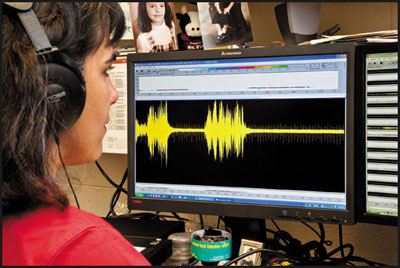“The Mystery of the Singing Mice”

Photo by Jeffery C. Beane, via the Smithsonian.
Many of us have heard about the apparent laughter of rats. Now, Smithsonian Magazine is reporting that a biologist at the University of North Carolina, Matina Kalcounis-Rueppell, has ascertained that certain high-pitched sounds made by mice could actually be melodious songs. Some excerpts from author Rob Dunn’s coverage:
In late 1925, one J. L. Clark discovered an unusual mouse in a house in Detroit. It could sing. And so he did what anyone might have done: he captured the mouse and put it in a cage. There it produced a lyrical tune as if it were a bird. A musician named Martha Grim visited the mouse, commented on the impurity of its tones and left, musical standards being high in Detroit. Clark gave the mouse to scientists at the University of Michigan. The scientists confirmed that the mouse could sing and then bred it with laboratory house mice. Some offspring produced a faint “chitter,” but none inherited the father’s melodic chops. These observations were all noted in a scientific article in 1932 and mostly forgotten.
Recently, though, Matina Kalcounis-Rueppell, a biologist at the University of North Carolina, Greensboro, revisited the mystery of the singing mouse. And after figuring out how to listen to mice on their own terms, she heard something entirely new. […]
The world of rodents, long thought mostly quiet, may be full of songs, broadcast short distances, from one animal to another, songs that we still know very little about. […]
Her discovery reminds us that each species perceives the world in a unique way, with a finely tuned set of senses, and so finds itself in a slightly different world. Bacteria call to each other with chemicals. Mosquitoes detect the carbon dioxide we exhale. Ants see polarized light. Turtles navigate using the earth’s magnetic field. Birds see ultraviolet markings on flowers, signs invisible to us. Snakes home in on the heat in a cougar’s footprint or a rabbit’s breath. Most of these different worlds are little understood because of the narrow reach of our own perceptions. Kalcounis-Rueppell hears music in the dark, but as a species we still fumble around.

Photo by Lynda Richardson for Smithsonian Mag. Kalcounis-Rueppell examines a wav file.
Anyone else having Stuart Little flashbacks? Ralph S. Mouse?
It’s remarkable, how new perceptions of something so tiny could make our world suddenly seem so much larger. The entire Smithsonian article is astonishing. Check it out, and make sure to listen to Kalcounis-Rueppell’s audio file of mice vocalizing. It sounds, for all the world, like the wooing songs of tiny whales.
Via Curt Tyler, thanks!

May 3rd, 2011 at 4:21 pm
If I had words: http://www.youtube.com/watch?v=sWxkv3fPsag
May 3rd, 2011 at 4:24 pm
Awww!
May 4th, 2011 at 7:35 am
positively magical. Thank you!
May 4th, 2011 at 11:50 am
Reminds me of Kafka’s short story “Josephine the singer, or Mouse Folk”
http://en.wikipedia.org/wiki/Josephine_the_Singer,_or_the_Mouse_Folk
May 4th, 2011 at 7:22 pm
oh yes mice do sing. Over the winter I had a mystery it involved a bobbed tailed mouse. He some how could get into my feed bin,but never could get out.I would then scoop him out with the feed can and off he go. after a few weeks he would just wait in the can for a ride out. Just how he got in I still dont know. i would move the bin,tied a tight cord around the bin, sat blocks on top,but there he was every evening….waiting! You can only imagine my surprise when I went to lift (Sparkles) out when he was curled up with another. How did she get there? That’s easy, for you know he simply SANG to her.